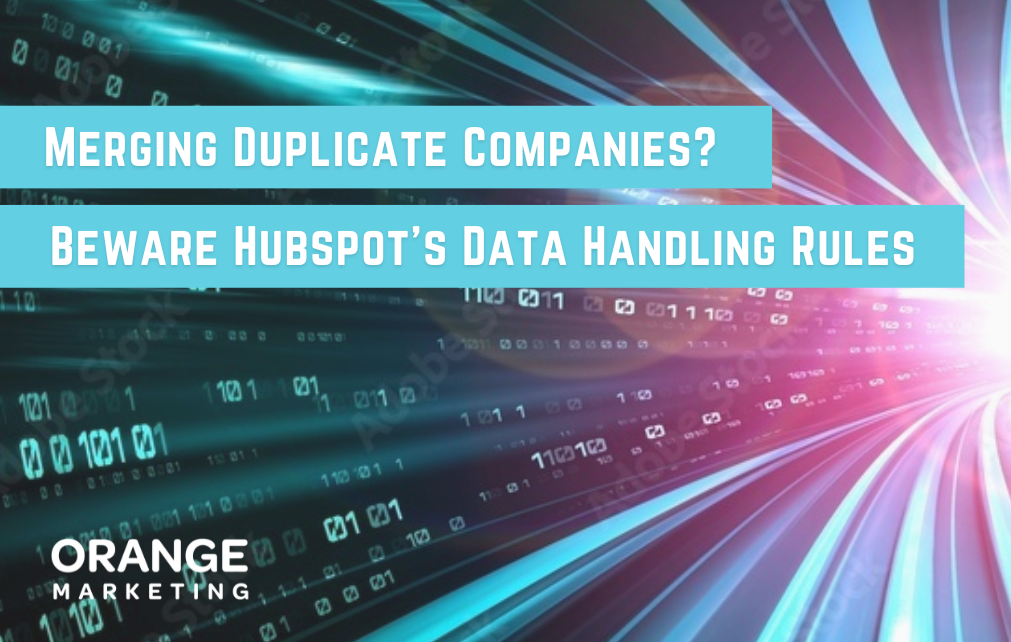3 min read
Merging Duplicate Companies? Beware HubSpot's Data Handling Rules
![]() Kirill Ougarov
:
February 27, 2024
Kirill Ougarov
:
February 27, 2024

Data hygiene is a critical for any successful company. A key component of maintaining that hygiene in HubSpot (or any CRM) is the management of duplicate records. While it may be tempting to simply delete those records, it’s not a reliable solution because it doesn't deal with the cause of record duplication – additional email addresses or email domains. Once the data is gone, you risk having the duplicate record created again in the future.
Deleting records also causes mismatches between current CRM data and any historical reports, as well as all activity data, some of which may be relevant to the retained central record. For these reasons, we advise... our clients against deleting records (there is no exception).
Fortunately, HubSpot makes it simple to merge duplicates and even provides a helpful duplicate audit tool – albeit one limited in functionality without an Operations Hub subscription. However, how HubSpot handles record merges can create challenges and cause problems, particularly when it comes to merging companies. Here's what you can do!
How duplicate company records Are created
While one person can have multiple email addresses, companies generally only have one domain. As a result, duplicate companies are a far less frequent occurrence.
Most commonly, duplication happens with multinationals that use country-specific domains for their overseas units, such as the Big Four accounting firms. It's possible to have dozens of company records for these firms, each tied to its own country specific domain.
For example:
pwc.com, pwc.co.uk, pwc.com.au, pwc.in and on and on and on.
For businesses that sell to these companies, it's important to rationalize these multiple records into a single entry unless the business decision is to treat each unit as a separate account.
how can merging these records cause problems?
The problems arise because of how HubSpot handles data for merged company records. HubSpot advises that:
All associations and timeline activities of both records will be merged and will appear on the primary company record. In general, the most recent value for each property is adopted by the primary company.
While there are a handful of key exceptions, including name, domain, lifecycle stage, create date, and original source, this "newest first" approach is where the potential problems arise. 99% of the time you will not want "newest data," you will want the data from your original parent record. For example Company Owner.
In most cases, the oldest company will be the "real" company that duplicate records get merged into. That older company record will be the one that has the appropriate Company Owner. Any other property values based on that record may be used to track where a company is in the sales process and who is responsible for any associated deals. As a result, any properties automatically set on creation will be copied from the duplicate record, overriding the true data.
This can be problematic for organizations that use the Company Owner to indicate who the account owner is, potentially causing confusion and frustration among sales team members. For organizations that use lead scoring, these data changes can also impact scores, creating further problems.
Is there a way to avoid data merge issues?
When merging records directly in HubSpot, the “newest first” rule will always be in effect – which record’s data is kept is, unfortunately, not a user setting. As a result, you (or your ops team) must be aware of which properties from the older company are critical to retain and manually set them to the appropriate value after the merge is complete.
Alternatively, there are third-party tools like Insycle that can merge records with different rules, but these add complexities and may be overkill unless you have a significant amount of duplicate records that need to be cleaned up.
The good news is that most HubSpot users will never have a significant number of duplicate company records, and the ones that occur can be handled manually. Implementing a regular duplicate cleanout process (weekly, monthly, or quarterly, depending on data volumes) will help prevent duplicate records from getting out of hand, much like regularly cleaning your bathroom will do the same when it comes to soap scum and grime.
Have a major data grime problem? Call in professional cleaners!
If your HubSpot data has gotten grody from a long-term lack of cleaning, you don’t have to struggle alone with the data equivalent of a sponge and bucket. Reach out today to find out how we can use our HubSpot expertise to get your data clean, shiny, and ready to use for making informed decisions at all levels of your business.
